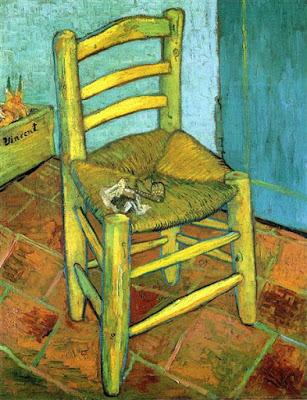Van Gogh's Chair by Vincent van Gogh
“But when we really delve into the reasons for why we can’t let something go, there are only two: an attachment to the past or a fear for the future.”Can anyone guess who said that? Do you think it’s from an ancient yoga text? Or a contemporary yoga book, maybe? Or possibly a bit of Buddhist wisdom? Well, you’re all wrong! It’s Marie Kondo from The Life Changing Magic of Tidying Up. I was so struck by that quote and the idea of how the things we own—and our inability to part with them—symbolize much deeper issues that I jotted down a note to myself to write a post about it one of these days. After all, both Ram and I have written in the past about the yama aparigraha (non-hoarding). See Aparigraha (Non-Hoarding) and Healthy Aging, Non-Holding (Aparigraha), and Aparigraha and Emotional Agility. So I was aware of the importance of letting go of things if you don’t use them (or no longer need them) and how sometimes that means letting go of associated thoughts and emotions as well.“If we acknowledge our attachment to the past and our fears for the future by honestly looking at our possessions, we will be able to see what is really important to us.” —Marie Kondo Then today my daughter contacted me to ask me about some old furniture of ours that she took with her when she moved to Texas. Next month she’s moving in with a friend in a house where there is no room for the coffee table, dining room table, and chairs. And she wanted to know whether she should pay to store the furniture, ship it back to us, or maybe just get rid of it. That forced me to quickly consider how I felt about those things, which held quite a lot of meaning for me. You see, my brother made the coffee table for me when I was about 25, and it was at the center of my living room until maybe 20 years ago when my parents gave me a very special custom-made table that had been in my home while I was growing up. And the dining room table and chairs had an even more weighted backstory. My mother had purchased them for my grandmother when she moved back to California, so some of my last memories of my grandmother revolved around meals she cooked for us and served to us at that table. Then when my grandmother died (also when I was in my early twenties) and we each got to choose something from her house, I choose the table and chairs, which I then used as the center of my family life until 10 years ago when I inherited my parent’s (much more beautiful) dining room table, which held so many memories for me of family dinners throughout the decades. Yes, attachment to the past.
"We live in the present. No matter how wonderful things used to be, we cannot live in the past. The joy and excitement we feel here and now are more important." —Marie KondoThe last few years I've been attempting to practice aparigraha and have gradually gotten rid of more and more things. But I’m sure that reading the “An attachment to the past or anxiety about the future” section in Marie Kondo’s book also made it easier to rise to this new challenge. I found it surprisingly comfortable to tell my daughter if she just wanted to get rid of all that furniture, it was okay with me.
I also like Marie Kondo’s idea of expressing gratitude to those things you’ve decided to let go of because I know that a gratitude practice is powerful one for counteracting negative thoughts (see It's not finding gratitude that matters; it's remembering to look for it in the first place). So I asked my daughter to thank that furniture for me if she decides not to keep it. I was worried she'd think that request was really weird, but she simply said, "I can do that."Subscribe to Yoga for Healthy Aging by Email ° Follow Yoga for Healthy Aging on Facebook and Twitter ° To order Yoga for Healthy Aging: A Guide to Lifelong Well-Being, go to Amazon, Shambhala, Indie Bound or your local bookstore.For information about Nina's upcoming workshops and retreats and other activities, see Nina's Workshops, Retreats, and Books.


